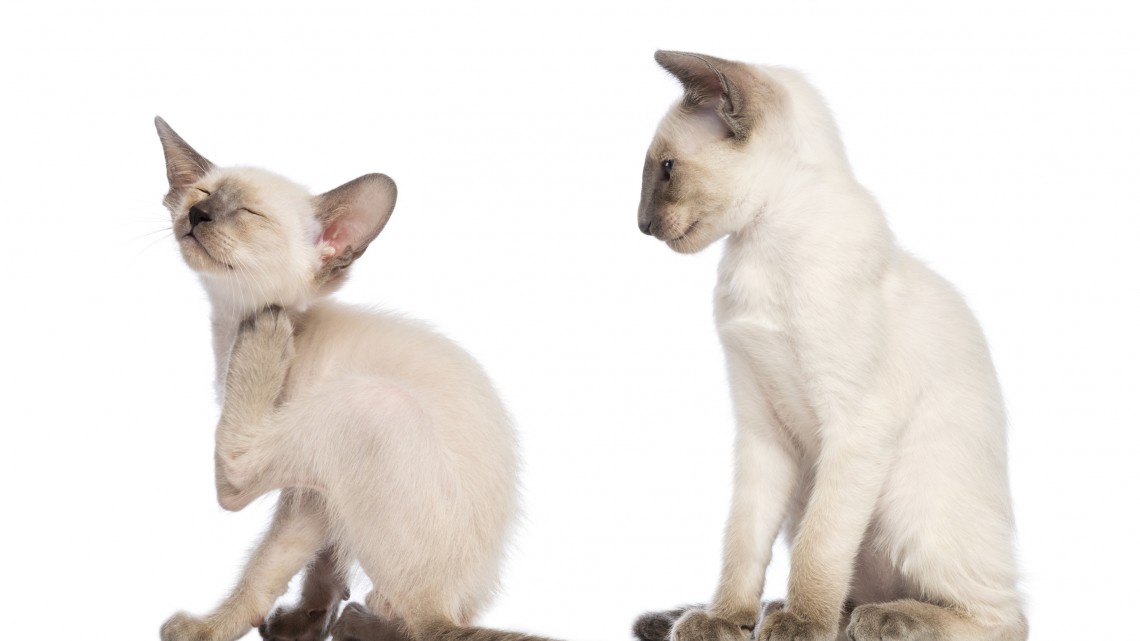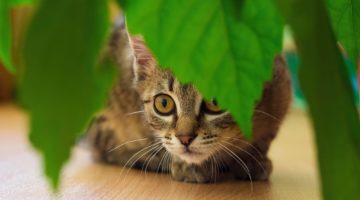Many seemingly innocuous household cleaners can make your cat sick. Protect your kitty from toxic chemicals by switching to greener alternatives.
Every day, millions of cats are exposed to toxic chemicals in the home. The simple act of wiping your counter or scrubbing the toilet can put your kitty at risk. It’s important to learn about the potential dangers lurking in household cleaning products, and how you can switch to greener, safer alternatives.
Manufacturers of household cleaners are not legally required to disclose a full list of ingredients on their product labels. Even if they did, would you know what alkylphenol ethoxylate or dodecylbenzene sulfonic acid are, let alone their potential health risks? As consumers, we assume these cleaners are safe for our families and animals, yet many contain toxic chemicals.
For example, 2-butoxyethanol is a common ingredient found in many household products, from all-purpose cleaners to carpet spot removers. Symptoms of hazardous exposure to 2-butoxyethanol include skin, throat and eye irritation, hemolysis (premature destruction of red blood cells), hematuria (blood in the urine), and depression of the central nervous system.
Bathroom cleansers, meanwhile, often contain sodium hypochlorite, which is highly corrosive and can irritate and burn the eyes, skin and throat. The Environmental Protection Agency describes this chemical as a “pesticide.”
While the level of chemicals found in household cleaners is deemed safe for people, this is not necessarily true for cats. Cats are especially at risk because they spend so much time lying on the floor, walking on the kitchen counter, hanging out in the sink, and even drinking out of the toilet. Any chemical residues they come into contact with they’ll lick off their fur and ingest.
A 2008 study by the Environmental Working Group examined toxic industrial chemicals in animals. Not surprisingly, the study found that the average levels of many toxic chemicals were substantially higher in animals than in people.
Do your research
Becoming an informed consumer is the best way to protect your cat and your family. You can learn if a cleaning product contains toxic chemicals by requesting a Material Safety Data Sheet (MSDS) from the manufacturer. Many MSDS documents are also posted online and can be found by searching for “MSDS” and the product name.
A product’s MSDS gives a quick summary of any hazardous chemicals and safety concerns. For more in-depth reading, check out the NIOSH’s (National Institute for Occupational Safety and Health) Pocket Guide to Chemical Hazards (see sidebar). This online resource enables you to look up a chemical by name to learn about its health and safety risks.
If you discover your household cleaners contain chemicals you don’t want in your home, be sure to dispose of them safely by following the manufacturer’s instructions. Many household cleaning products are considered hazardous materials and must be taken to special drop-off centers.
There’s one more precaution to take before you stock up on green cleaners to replace chemical-based ones. Watch out for natural cleaning products made with citrus oils. According to the Natural Resources Defense Council, citrus oils and many other common essential oils are toxic to cats. Their website provides a detailed list of which oils to avoid.
Clean green
By now, you may be wondering what you can use to safely clean your home. To help you navigate the world of green cleaners, here are some eco-friendly options to keep kitty’s favorite hangouts safe and sparkling clean.
Carpets
Use a natural enzyme- based carpet cleaner to tackle your cat’s accidents or other spills. Enzymes are biomolecules that “digest” stains and odors. Usually you’ll need to saturate the carpet with the product and allow it to sit a few hours while the enzymes do their work.
Floors
Laminate floors can be cleaned using a solution of one cup vinegar to one gallon of warm water. To protect the finish on hardwood, natural stone and ceramic floors, the best option is to damp mop with water only. Wring the mop out so it is almost dry and mop the floor twice, rinsing thoroughly between washings.
Counters
Many eco-friendly counter sprays contain citrus oils, which you’ll want to avoid since they can be toxic to your cat. Look for fragrance-free products and read their labels; most eco-friendly cleaners list the ingredients on the package.
Sinks and tubs Baking soda is a safe alternative to commercial abrasive cleaners. For best results, give the sink or tub a quick rinse so the surface is wet. Then sprinkle the surface with baking soda and scrub in a circular motion with a slightly damp sponge.
Toilets
Toilets can be kept fresh with regular use of baking soda. Dust the bowl and toilet brush with baking soda and scrub as usual. For deeper cleaning, choose an eco- friendly toilet bowl cleaner that contains lactic acid, a plant-derived demineralizer. To protect your cat from any essential oils in the product, keep the seat lid down until you have flushed the toilet a few times.
Whenever we grab a cleaner to wipe up the floor or scrub out the tub, we’re usually just focusing on getting the job done and don’t think much about what’s in the product. But even if your cleaners don’t cause you any symptoms, they can make your feline friend sick. Switching to non- toxic alternatives is healthier and safer for both of you.







No Comment